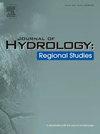A multi-model study of the subsurface and surface hydrodynamics of a 700 km2 watershed in western Canada (Fox Creek area, Alberta)
IF 5
2区 地球科学
Q1 WATER RESOURCES
引用次数: 0
Abstract
Study region
A 700 km2 watershed near the town of Fox Creek (west-central Alberta, Canada), a region that has seen intensive oil and gas production since the 1950s, is investigated.
Study focus
The overall objective is to improve our understanding of the hydrodynamics of this watershed. The hierarchical multi-model approach uses physically based numerical models and follows a stepwise progression, transitioning from saturated and variably saturated groundwater to integrated surface water–groundwater (SW-GW) models. This progression encompasses 2D and 3D configurations from a deep (∼1 km) hydrogeological multi-layer aquifer system to a shallow (45 m) coupled flow system. This differs from other multi-model studies where the focus is on comparing simple to complex models for a fixed domain.
New hydrological insights for the region
The hierarchical modeling approach has led to better insights and estimates of processes including vertical recharge and lateral groundwater contributions. Moreover, it allowed us to corroborate hydraulic conductivity values and groundwater recharge despite the limited dataset. The hydraulic connections between the four non-marine bedrock units were shown to be negligible, allowing us to focus on the Paskapoo Formation. The unsaturated zone was shown to play a significant role in the model response, and accounting for land surface–subsurface dynamics was demonstrated to be critical to properly estimating hydraulic head profiles and land surface saturation patterns.
加拿大西部(阿尔伯塔省福克斯溪地区)700 km2流域地下和地表水动力学的多模型研究
研究区域在Fox Creek镇(加拿大阿尔伯塔省中西部)附近700 平方公里的流域进行了调查,该地区自20世纪50年代以来一直是石油和天然气的密集生产地区。研究重点总体目标是提高我们对该流域水动力学的理解。分层多模型方法使用基于物理的数值模型,并遵循逐步发展,从饱和和变饱和地下水过渡到综合地表水-地下水(SW-GW)模型。这一进展包括从深层(~ 1 km)水文地质多层含水层系统到浅层(45 m)耦合流动系统的2D和3D配置。这与其他多模型研究不同,这些研究的重点是比较固定领域的简单模型和复杂模型。分层建模方法使人们对包括垂直补给和横向地下水贡献在内的过程有了更好的认识和估计。此外,尽管数据集有限,但它使我们能够证实水力导电性值和地下水补给。四个非海洋基岩单元之间的水力连接可以忽略不计,使我们能够专注于Paskapoo组。研究表明,不饱和带在模型响应中起着重要作用,考虑地表-地下动力学对于正确估计水头剖面和地表饱和模式至关重要。
本文章由计算机程序翻译,如有差异,请以英文原文为准。
求助全文
约1分钟内获得全文
求助全文
来源期刊

Journal of Hydrology-Regional Studies
Earth and Planetary Sciences-Earth and Planetary Sciences (miscellaneous)
CiteScore
6.70
自引率
8.50%
发文量
284
审稿时长
60 days
期刊介绍:
Journal of Hydrology: Regional Studies publishes original research papers enhancing the science of hydrology and aiming at region-specific problems, past and future conditions, analysis, review and solutions. The journal particularly welcomes research papers that deliver new insights into region-specific hydrological processes and responses to changing conditions, as well as contributions that incorporate interdisciplinarity and translational science.
 求助内容:
求助内容: 应助结果提醒方式:
应助结果提醒方式:


